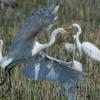
New research suggests that the effective management of protected areas in Europe can help to advance the range shifts of wintering water birds toward the north as the climate warms.
Conservation policies have historically been aimed at stopping or mitigating species extinction, habitat degradation, and the depletion of natural resources. Today, the objective of such policies is moving toward facilitating species’ responses to climate warming. This includes making it possible for species to move through a landscape so they can continue to live in a habitat that meets their needs in terms of climate and environment, and to prevent populations from being trapped in areas that no longer have a suitable climate.
Research shows that climate warming push species ranges toward the north. Many species are, however, not able to adjust their ranges fast enough and cannot keep up with the rate at which the climate is warming due to pressures on nature that result from human activities, such as habitat degradation and over-exploitation. For this reason, protected areas play an important role in helping species to adjust their range change to climate warming. However, it is not clear which characteristics of the protected areas are helpful in this respect.
A recent study directed by Professor Jon Brommer from the University of Turku that I worked on, sheds light on which characteristics of protected areas are helping range shifts in wintering water birds in Europe. We investigated how the composition of non-breeding water bird communities within the European Union Natura 2000 (N2K) protected area network changes in response to increases in temperature. N2K is a network of core breeding and resting sites for rare and threatened species, as well as some rare natural habitat types that are protected in their own right. It stretches across all the EU Member States, both on land and at sea, aiming to ensure the long-term survival of Europe's most valuable and threatened species and habitats
As part of our study, we measured the community reshuffling of 97 water bird species in 3,018 N2K sites over 25 years in 26 European countries. We found that water bird communities adjust faster to climate warming inside protected areas that have a management plan, compared to protected areas without such a plan; and that the adjustment to climate change was particularly strong if there was a management plan for a protected area targeting the protection of water birds, compared to other protected areas.
In fact, the range shifts of water birds were more than twice as fast inside protected areas with a management plan targeting the protection of water birds, confirming that management plans play an important role in facilitating water bird adjustment to climate warming and should be more systematically implemented.
Thanks to the protection measures implemented as part of the plan, the community adjustment to climate warming mainly resulted in colonization by new southern species and rarely by the extinction of species vulnerable to climate warming. Overall, water bird species richness increased inside the N2K protected area network, and even more inside protected areas with a management plan.
In addition to conservation efforts, the surface of protected wetlands was an important parameter helping water bird communities to adjust to climate warming in our study. Shifts in species communities were again faster in Natura 2000 protected areas that had large wetland habitats.
Our findings highlight that the protection of key habitats for water birds – wetlands – is crucial to mitigating the negative impacts of climate warming on their populations. Well-managed protection of especially larger wetlands assures that a thriving assemblage of wetland birds, and of course the various ecosystem services these birds can provide, will persist in the future.
The research was based in international collaboration between researchers affiliated with 33 research institutes across Europe. The international coordination of surveys was conducted by Wetlands International and the research was published in the scientific journal Conservation Biology. The work was funded by a joint funding initiative of the European Union’s Biodiversa network, together with the Belmont Forum and the Academy of Finland.
Reference:
Gaget, E., Johnston, A., Pavón‐Jordán, D., Lehikoinen, A., Sandercock, B., Soultan, A., Božič, L., Clausen, P., et al. (2021). Protected area characteristics that help waterbirds respond to climate warming. Conservation Biology (In Press) DOI: 10.1111/cobi.13877 [pure.iiasa.ac.at/17725]